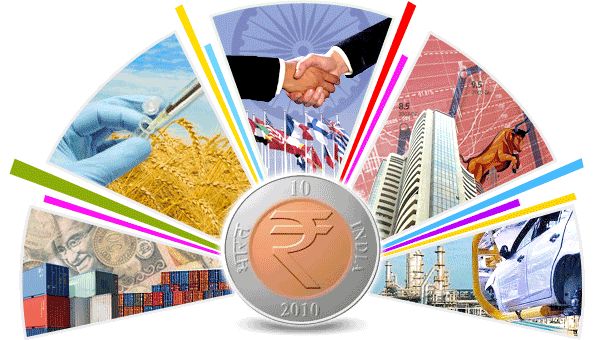A country’s growth rate is the percentage increase in its real GDP over the previous year. Speaking in a rigid statistical manner, India grew at the rate of 3.5% (famously known as the Hindu Rate of Growth) till 1991, only in the 2000s achieving growth rate was over 7%.
But, the real question such numbers wish to answer is, are we living better lives than our forefathers?

To answer that question we need to track India’s economic journey since her independence day.
At the time of independence
When India won her Independence, the country was in shambles. Per capita income was as low as Rs.230/head. Illiteracy, poverty, famine, lack of proper housing, inadequate food stock plagued our country. Years of deindustrialization policies, by the former colonial masters, made the industrial sector impotent and almost non-existent (sparing the few like Jamshedji Tata). Under such dire circumstances the leaders of the country decided to forge India via a planned economy. Hence the draft of the first five year was drawn up by the planning commission. Its primary goals was to increase the production of food, control the inflationary pressure among others. The first five year plan (1951-1956) was a success, as national income grew by 18% to Rs. 10480 crores from Rs. 8850 crores. Per capita income also increased by 11%.
Population growth rate and the Permit Raj
Mahatma Gandhi, wanted Indians to be self-sufficient and encouraged cottage industries (common features of Gandhism). But Jawaharlal Nehru’s vision of India was far more complex. He wanted to industrialize India. Thus Pandit Nehru along with statistical genius P.C. Mahalanobis formulated the Industrial Policy Resolution of 1956. Taking clear inspiration from the Soviet’s, India opted for Central Planning and the Socialist way, under which the government would own and operate major capital industries. Also the country followed what is commonly known as import substitution policies, which basically cut off the subcontinent from the rest of the world. Though this seemed like the perfect system for industrialising the country, alleviating poverty, generating employment and overall improving the standard of living of the people but things are never that simple.
Overtime India’s overprotective outlook made competition in any field non-existent. Entrepreneurs would have to wait months for permits and licences. Often bribes have to be paid to acquire such licences and permits. The lack of competition took away the incentive to innovate and bring better goods and services. This ultimately affected the consumers who had to buy sub-standard goods. Thus the British Raj was replaced by the License Raj. From 1950s to 1980s, growth stagnated around 3.5% while per capita income grew at 1.3%
New Economic Policy (1991)
Now by this time a lot has happened in the World, wars in Korea and Vietnam and Afghanistan, temporary rise in the oil prices caused by the OPEC, and ultimately the collapse of the Soviet Union. India too found herself in a dire state. Wars with Pakistan and China proved costly and left the government with a huge fiscal deficit. The Gulf war caused the oil prices to shoot up, making oil imports expensive. Ultimately, India found itself with foreign exchange reserves to support its imports for just two weeks. In the midst of such crisis, economist Dr. Manmohan Singh was appointed as the Finance Minister. Dr. Singh formed reforms, collectively known as the New Economic Policy of 1991. Under the new system, PSU were disinvested, tariff, subsidies, import duties were reduced, many industries were delicensed and private enterprise was encouraged. In the thick of crisis, this proved to be boon for India. The country was on the verge of collapse and needed a bail out. Financial assistance did not come cheap as India had to pledge tonnes of gold and agree to the conditions set by the International Monetary Fund. But such global embarrassment proved exactly India needed, as after liberalizing India’s growth kick started.
The New Millennium
This millennium ushered in a time which was previously unimaginable, it saw invasion of the US of Iraq over imaginary weapons, one of most horrific acts of terrorism on 9/11/2001, which made Islam single handily the enemy of the world, the burst of the housing bubble which pushed most of the developed world into the 2nd worst depression of all time, we saw the fall of al Qaeda and rise of ISIS, and most recently the Brexit. Such events shaped and shocked socio economic and political sphere, and made the world we find ourselves in. Yet despite such turbulence in the global economic and political landscape, India along with her communist neighbour fared pretty well. While China became the factory of the world, growth in India was driven by the service sector, with Information technology (IT) leading the way. Service sector as a percentage of GDP grew from 41% in 1990’s to the 51% 2003. Most of the services were exported, as outsourcing grew. GDP grew at an exceptional rates of over 7%. Overall marking a good decade for the subcontinent.
Now to the question which was asked before, are we leading better lives?
The simple answer is yes, a certain section of consumers in most cities have a living standards which exceed in both scope and quality. But the real question is how many of us have access to such lives? Writing from one of the major metropolitan cities, with easy access to both the necessities and luxuries of life, I can confidently and wrongly say everyone is happy in this country. Yes the cities have improved, but most of our population doesn’t reside here. In order to know the true Indian growth story one needs to visit the hamlets, and see whether the people there have clean water, whether their children are receiving quality education, whether they have good “Pukka” roads among other utilities. India has grown but that growth has touched only few in the nation of millions. The service sector has grown but it still employs only 21% of the labour force. Although a lot has been done, loads is left to be done.






























